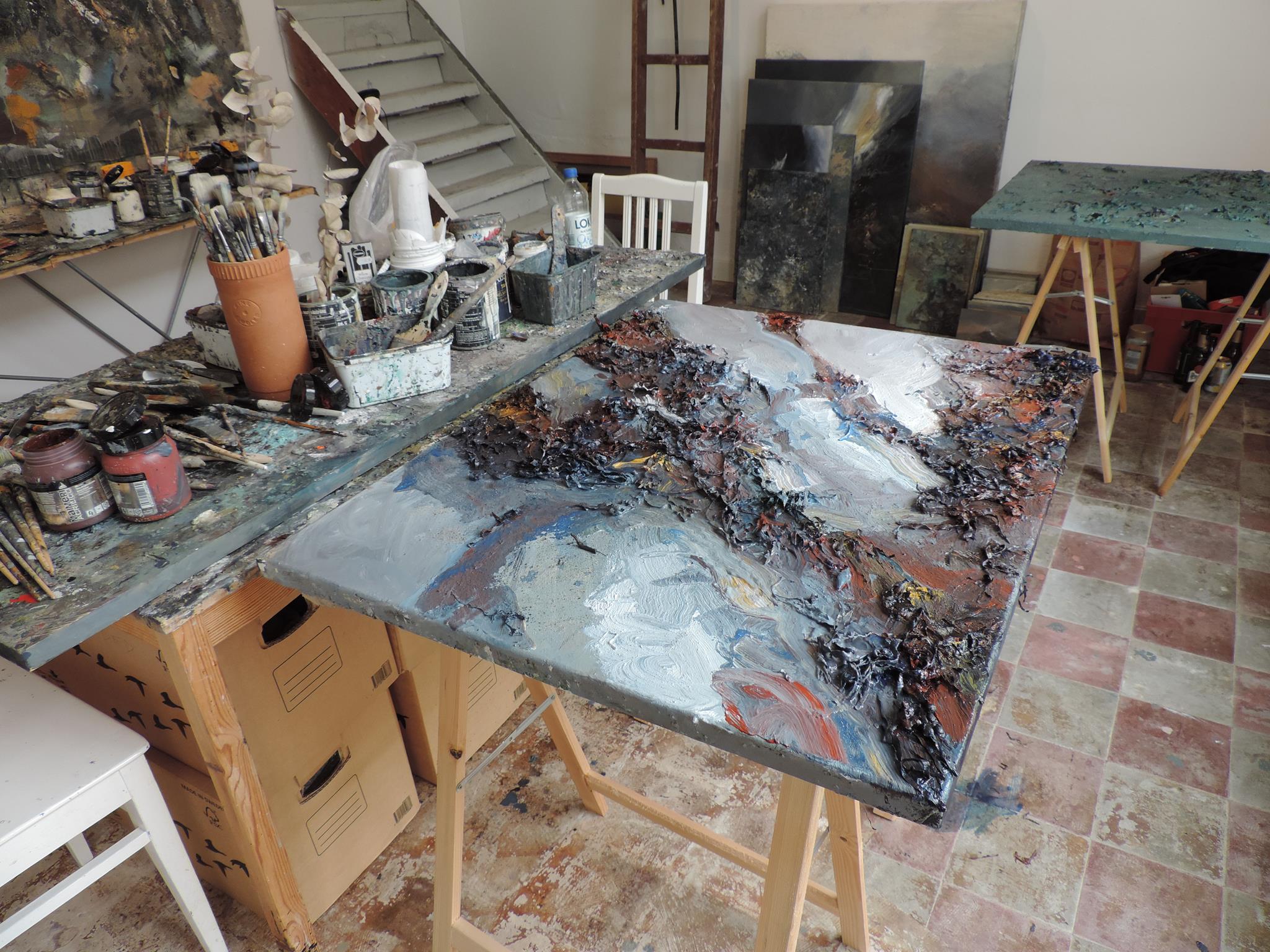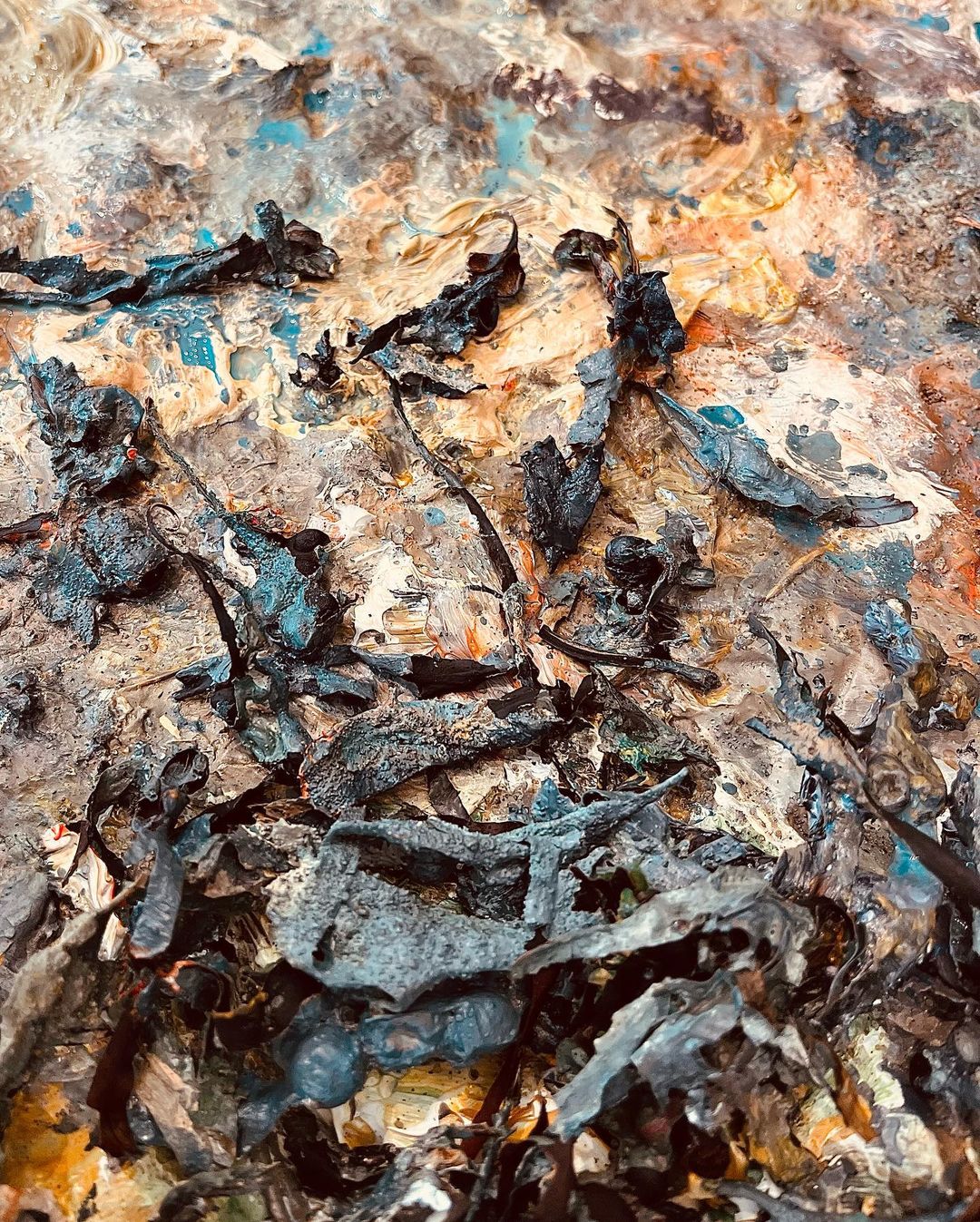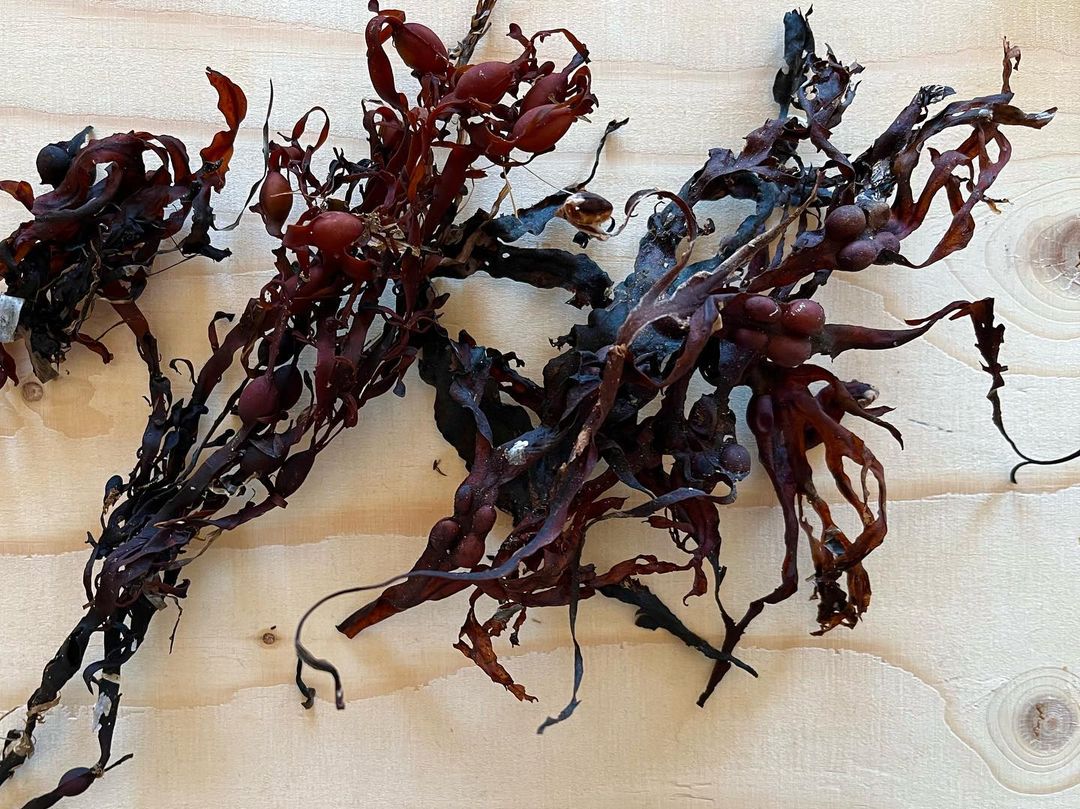The artist FILIP REM paints an abstract world that develops piece by piece during his painting process. The atmosphere has to be right and it is all about a certain expression. Sometimes he paints over a work numerous times in different ways, adds appliqués or even parts he found in an old paint can. In the end, it just has to fit, and if it does, that’s what his feeling tells him.
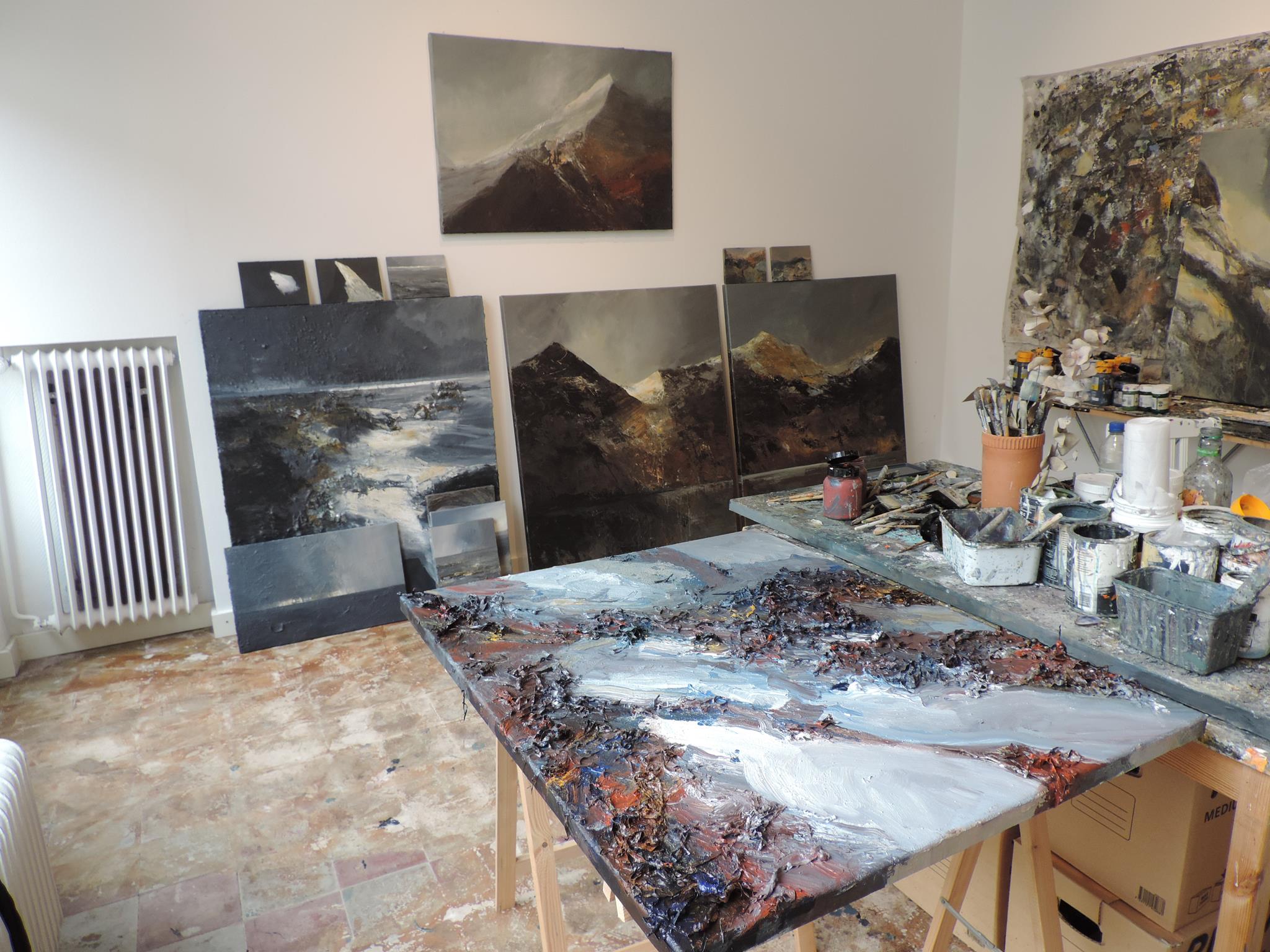
FILIP REM creates abstract art, but what is much more interesting is how he does it. It is a processual work with different stages and phases. Everything is again very dependent on the connection he builds with the works. Because they are his expression and the expression of his feelings and of himself. A true artist!

We had an interview with FILIP REM. It was a really interesting conversation, but it came out of a coincidental situation. This super cool interview is the result of it. Here is the podcast to listen to and for those who prefer to read, the written version is below. In between there are photos of FILIP REM’s fantastic works and the great studio.
When I was just passing by and I saw you working on the new painting it fascinated me how you put on the different applications on the canvas. But you do a lot more besides abstract, you have mountain sceneries and colorful worlds. Tell us more about your art and what you do.
The first thing I would say, as for many, it is an expression. And I think when I am trying to describe it, I say it is a way of expressing myself and also about understanding the world. I used a lot of things, colors and materials which go with the colors. Like for the textures for example sand or gravel and stuff like that. Basically all in all it makes me really curious. When I say about understanding the world, it is about myself and the world. I believe everything is connected. Everything is sort of a whole. And for me I think this is a way of express everything. This space here, my studio, there everything sort of fits in here.

Just before the recording started we were speaking exactly about that. So you start a painting, you paint and then in the end you have a finished painting, but the art itself is much more than just the painting. It is the whole process. Or this protection wall you showed me and which became after several paintings an artwork itself. Or those instruments you are using, you said you even put those little metal tools on the wall at an exhibition once. Event the equipment is part of the art and like you said, everything is connected. Actually your whole atelier is one big artwork.
Yeah, I think it is the whole space and the atmosphere. I think the whole process is the artwork. From the tools which I use for making it, the brushes and those kind of plaster shovels. Actually that is a building tool and I scrape the paint sometimes with that. In the whole of the process a lot of coincidences are happening. Like you are passing by. And I believe you can stand here the whole day and cannot achieve anything. I don’t know if that is the right way to say it. But then suddenly you find some jumbled paint in the bottom of a can and that sort of says the right thing. Instead of the normal paint that didn’t work out at all. It is kind of a play for me and it is intuitive. Somehow the paintings and the things around them evolve intuitively basically. That is interesting to me to work that way. Then maybe it becomes a mountain or it becomes the sea or waves or stones or roots or whatever. But basically what I do has a lot to do with nature. We are nature as well.

When you think about the painters of realism who really planned the painting from the beginning, they sat down in front of a tree and they knew exactly that they copy that tree now 1:1. What you do is completely different. You start a painting and then go with the flow and look what will happen. And with every new layer, with every new puzzle piece you add, it can go maybe in a total different direction. You just try to go with it and I think it is also always kind of a surprise what the result will be.
Definitely. I paint over a lot. So most of the paintings have a lot of layers. I think it is an interesting way of working. Of course I understand all the kinds of realistic works and the realistic paintings and I like many of those a lot. But what I do is different.

You have a different way of expression. Let’s say it is more the way how you find the ingredients till the artwork is finished, it is more intuitive. And the painting evolves with every step. There is not a planned path from the beginning, but there is more a figuring out the next step on each part of the step.
Yes, and when we talk about the layers, it becomes a lot of layers when you work like that. Because if I start to do small things on a painting it starts to sort of happen all at once in a way. If I have a motif or a painting, maybe it rests for a while and I often ask myself “Does it feel right? Is it whole?” or “Does it keep feeling right?”And if not, then I maybe take it up again and paint on it. And then often it comes to it that I paint over little things or over the whole in one flow. That is building layers, but as well the things which I put on the painting. Sometimes I do that with the applications, but sometimes it is just paint. But I often have some kind of things on it.
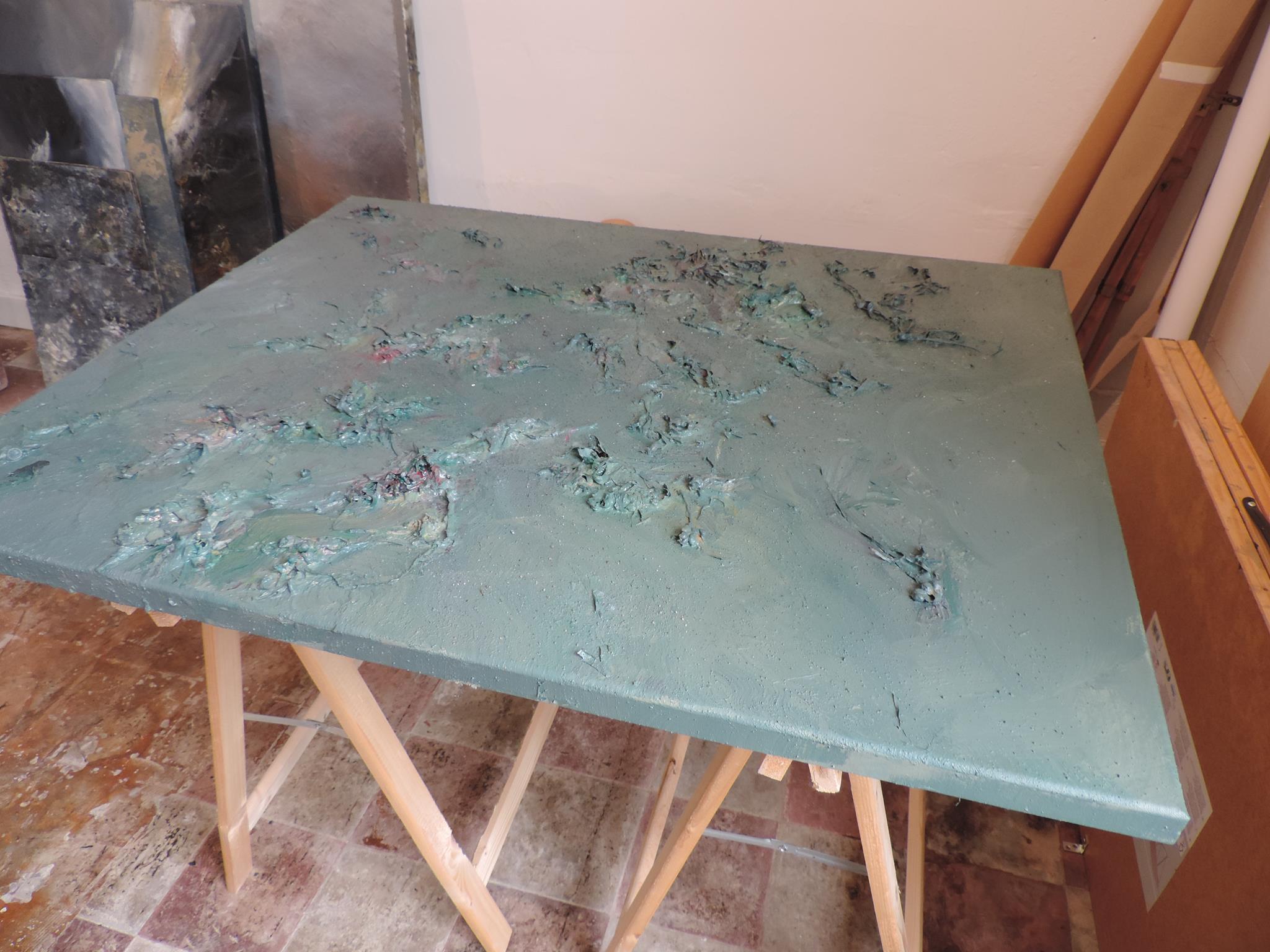
So you could say, the finished painting is just the moment when you decide that you feel good with it. But actually there are maybe like 30 different layers on one canvas. Those are different levels or stages of the painting and you choose that this one is now your finished result. But like with that protection wall, for somebody else who doesn’t know what it is, they would say “Wow, this is a cool painting!”. So if you have a painting and you would photograph it in every stage, it would be interesting to ask the people which version they like the most. Maybe a lot of people would choose the number 10 or number 15 or whatever. Then there would be lot of different kinds of perspective, but the finished paintings are the versions which you choose yourself.
I think you are absolutely right about that. Every canvas here has at least 10 or 15 other paintings in them. So I kind of start like that. I don’t say I am painting a mountain or roots or the sea or whatever. It is sort of evolving over time. And sometimes the canvases stand for a while and I tend to paint over a lot of those. And then at some point it is just done. Then it says the right thing and I feel it. It is the only thing which I can say in terms of “This looks good”. I can say that the colors are nice or whatever. But the only way of actually deciding that it’s done if it is feeling right.

Compared to the opposite feeling when it is not right or when you have the feeling that there is something missing. Then you keep on painting.
Exactly. And I am trying to get to that point that it feels right. So it ends up being like that and I just paint over the whole painting. It is interesting what you said about the other people and who would like which version. I am also trying at first to keep the work and what I do away from other people’s thoughts until it is finished.

Yes, because you are the artists and you paint what you like and not what the others like.
Yes, exactly. So I think the important thing is that the expression is mine. That it is my art and my expression. And then the encounter with the viewer or the persons are coming to the gallery and watch the paintings. It is sort of just between them. It has basically nothing to do with me directly. It is becoming a silent dialogue about us.

I think this is a very main principle of the difference between an artist and like for example a painting agency. Because somebody could come to you and say “Can you make this painting here, but on the upper part with some more red an on this other part with more green?”And you would say “Yes, I could do that. But I am not going to do that, because it is a different concept. That’s not me”. You paint as long till you have the feeling that the artwork is finished. And that is your expression. The other concept would be like when you give an order to an agency and you say exactly what you want. For example a dinosaur with a yellow hat. And they do it for you but that is not like the work of an artist like you. They actually paint everything you want. I think this is one of the differences. Still you could say, yes you would do it. For 100 Euro you can paint somebody’s house in blue and white, but this would not be your expression. Some artists do both, because they need to earn money. But if you don’t have to then a real artist would say “No, why should I do this. That is not me. I only do the expression which comes out of me. If you like it, nice. But if you don’t like it, I don’t care”.
Yes, you are right about that. And I think that is also the space of free expression. Of course I often invite people in here, some knock on the door, for example like you did. It is kind of a social thing which is really interesting, exciting and fun. It happens that you talk about the art or about other stuff. About life or a dog or whatever. I think this is a place for me for my expression and for me it is important that the viewer has an own perspective. I mean the people can like it or not. But it is not really important. But yes, it is nice if it moves them in some way. I think it is important that there is a dialogue between the painting and the viewer then and not directly with me.

But in the end it is also with you, like indirectly. Because you put your own expression into the painting.
Yes, in the end it is of course also with me. But that is the silent dialogue between us. And I think this is very interesting. Because when you work with abstract art or also with realistic works, I think some people like to discuss what they see in the painting and what they feel. It might be what I see or it might be something else. And that way I think we can have this kind of silent dialogue. It is super interesting when that happens.

Of course. Because you never know what kind of ideas or feelings it would cause in the person who is observing the painting. There are paintings, maybe the people don’t like it, but it moves them a lot. And they find it interesting. They say maybe it is not very nice, but they are just fascinated by it because it touches them in some way. I think an artwork doesn’t has to be nice. An advertisement yes, like we said before, this has to be nice. But art itself, it is not a question about being nice or not nice. I think it is about opening this dialogue and to get to the soul of the person, to touch them, to move them and to give them some inner effect.
Yes, definitely, and when I work with these things it is often that I actually don’t understand what I am doing. Until afterwards. But that can maybe take weeks or months. And then you suddenly find something and then you suddenly understand what this is. It is a kind of reactive thinking. When you do then you do it with your body, it is just the body, and then you do the thinking afterwards. Or like reflection or whatever you call it. And that is also an interesting part. Because it can happen that there is painting and there is something with it, but I just cannot really describe it. I cannot really say what it is. And suddenly after a few weeks or months I can see what it is. So that is the thing. Or maybe I paint it over at that point. That is an interesting thing for me.

Then in a retrospective you say “Oh, now I see. Now it all makes actually sense.” But when you have been inside the process you couldn’t see it from above.
You need time and then it can evolve in a way by itself. And it is very important that there is room and space for everything. So happiness and also sorrow, light and also darkness. All these things we feel and which everybody feels. And I think it is important that for the artworks the space and the canvases can hold all those things. That there is space for all those things.
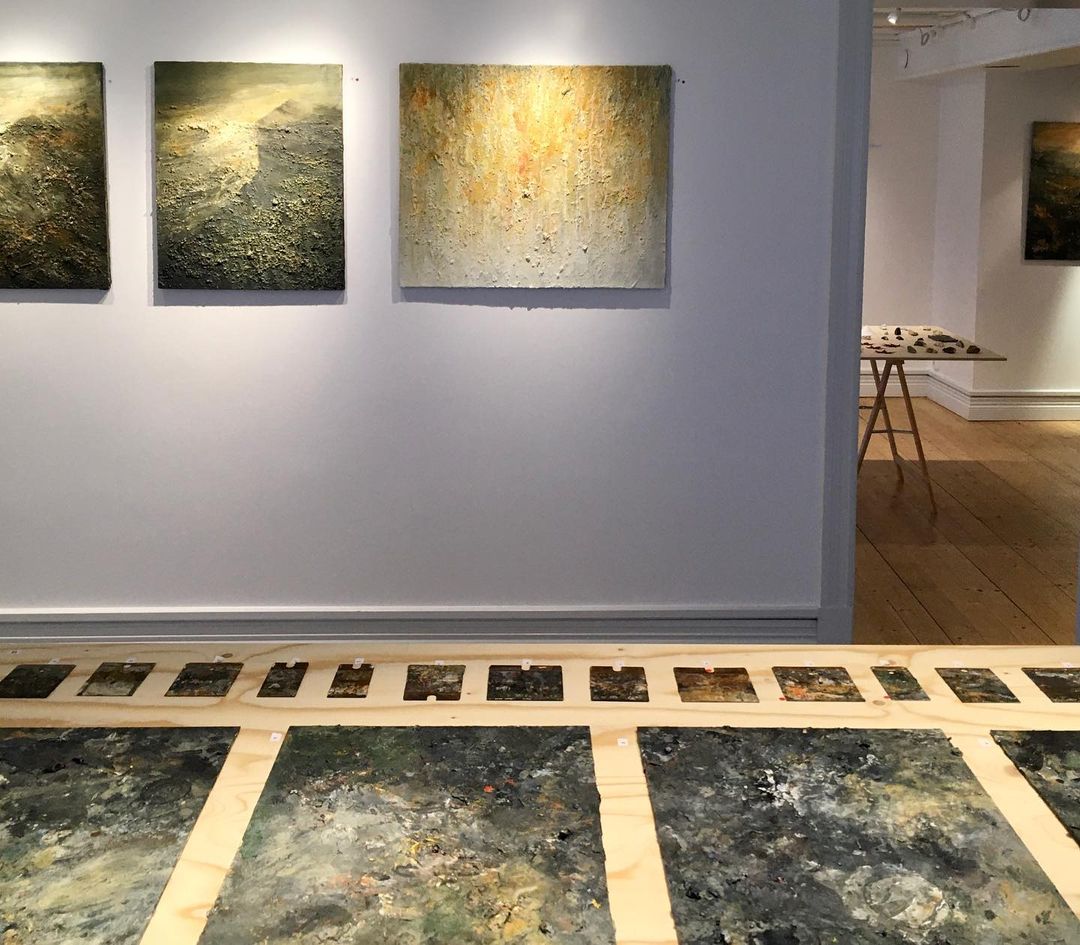
Let’s now go back in time for some years and to the beginning of your art. When did you start painting and how did it come that you started doing abstract art?
It has always been an expression for me. I think that is the case for many people who are artists or people who are working with creative stuff and doing things. That it is an expression. So I am been doing this since I was a kid. But in a professional way it is only maybe for ten years. Now it is part of my profession. But I have been doing it a lot earlier and I have always been doing this. Also when I was a kid it was kind of an expression for me, like also for many other people. All people have different kinds of expression and for me this is what I do. So I was always doing it but I have no formal art education. My education is basically in architecture and I was working with that for many years. Back then I did some paintings on the side a little bit, but at one point I just knew that I needed to express myself more in that way.

It was as well a process. So there is no special date or a moment, it was over time more and more evolving. Like the paintings.
Yes, definitely. And then it just sort of took overhand. And that was maybe around ten to eight years ago. Then I was doing it on my spare time and then just more and more as a job.

And now you are a full time artist?
I am not full time, I would say I am doing this about 50 percent of my time. So half half. I also work as a teacher and also do projects as an architect. So it is very good and I can combine the different fields. It is also important for me and as long as you can live with doing what you do, like in this place here, it is good to have some other things and options. Also it is inspirational, but as well that way I can let this place here be free and for free expression. Like we talked about before.

Yes, that is good. So you don’t completely depend on the art. It can be good, but also it can be a bit struggling. Because you have also other jobs then the art area is maybe a bit more free. You can be more free in expressing in your art because you are not completely dependent on selling artworks. You also have your other jobs and that way you maybe don’t have so much pressure on selling things. So you can do your art a bit more relaxed.
I agree with that and if you can live on it fully and also do that expression, of course that is perfect. But it is not like that for me. So I rather do a job which is alright and fun, like teaching the students is really fun, it is nice to give and you get a lot back. But also the result is that I have the possibility to keep this space and the expressions free. I am really thankful for that. At least in my situation I rather keep it like that. Because we spoke about that before, the things which come out, the expression, it needs time and space.

I have this picture about an author who is writing a book and then he gets a phone call: “Hurry up, the book has to be finished in five days!” And then the guy is really trying to press the words out of his head and then he or she thinks it is just not good. Because there is a lot of pressure on it and you cannot program the ideas. And like you explained before, often you paint over a painting a lot of times. So the process needs its time to be done. Sometimes it can be fast, but sometimes it can also last over weeks or month.
Yes, definitely. And there are even artworks which have been around for a couple of years. Then it is really important to have time and space. Of course you have deadlines when you have an exhibition for example. Then you need to work on it to finish artworks, but I tend a lot to make it according to the show space. I try to see the exhibition place first and I want to see how it resembles and to think about how it can be filled. How is the atmosphere there and all that. Then you gather up stuff, pieces, maybe you paint something for that also. But normally it is more about trying to get the dynamics right. To get the space and the atmosphere right. And that needs time. Of course you have deadlines but I would not say it is the same like we were talking about before. It is a different thing. I am tending to see that and I am trying to understand it better and better. Like I said, I am not doing that professionally for that many years, so I experienced when I had events that I also was used to those deadlines from my other jobs. Like from my work as an architect. So it was also easy for me to see that or to fall into that as deadlines. And at first that made it in a way really hard to make the exhibitions. Because I saw it as a deadline. But then I was thinking “What is wrong here? It doesn’t feel right.” Maybe this is totally obvious for a lot of other people, but for me it wasn’t. So now I am trying to see it as a cut through the process at that specific point. The process is still always ongoing, like everything. And that is now how I am doing it and saying it to myself. Like we already said, everything is connected and always ongoing. So when I try to see it as a finished thing, then it dies. By seeing that process ongoing and then when you have an exhibition or you have something that has to be shown, you just cut the process there. Then you just show the artworks as that what it is right now.

Let’s say that is the compromise what you do. Maybe from ten of the paintings you use, they are kind of finished and feel right, but with the other ten, they are not finished yet and there you just cut the process. With those you just show how they look at the moment, because the exhibition starts. Most people would not even recognize and they would not really know if the painting is finished from your perspective or if not. Only you know it. But you have to show the painting, because the exhibition starts. But the process of the painting is actually not done and is kind of broken.
Not that much, because when I say to cut the process then I would not do an exhibition with pieces that are in process that doesn’t feel right. It has to be on some certain level of the process. Maybe it is not completely finished but at some point close to it. So it needs to feel right. When it is feeling right, then it is also basically done. The paintings need to be done to some level. And the ones that are in process they can be shown if they feel alright and if they fit in that space or in that sort of atmosphere in some way. Maybe I do something differently with them, so I could put them on a table or something like that to give them a place in that atmosphere. But mostly I tend to show the finished paintings on exhibitions. If it is not possible, then I do this with cutting the process and I try not to force anything. That is the important part which I am talking about. Not to force yourself to finish a painting for an exhibition. Because it has its own life so to speak.

About exhibitions, tell us a bit more about that. Where did you have exhibitions yet, when was your first exhibition and how is it for you to show your artworks at events to others?
I had a few, not that many yet. When I was younger I was applying for those bigger exhibitions with many artists where you can be on art museums. Here in Sweden we call them Salons. But the first solo exhibition which I had was in a small gallery in Gothenburg in 2015. Then I had a couple of more exhibitions at that place, it is called Arkiv 8. And then last year I had a bigger solo exhibition in Borås at Flaménska Galleriet, that was really fun. Then this year I had another exhibition at Partille Konstörening in Partille Herrgård. So I had a couple of exhibitions, not that many, but around 6. At the first time I was really nervous and afraid. Because it is an expression and you are sort of putting yourself out there. I was just not used to that at all and it was the first time, so I was nervous. But once doing it, then it is fun and when people are come watching it, then you can talk about it. It is interesting to see and hear what other think. It can be very grateful when others come to look.
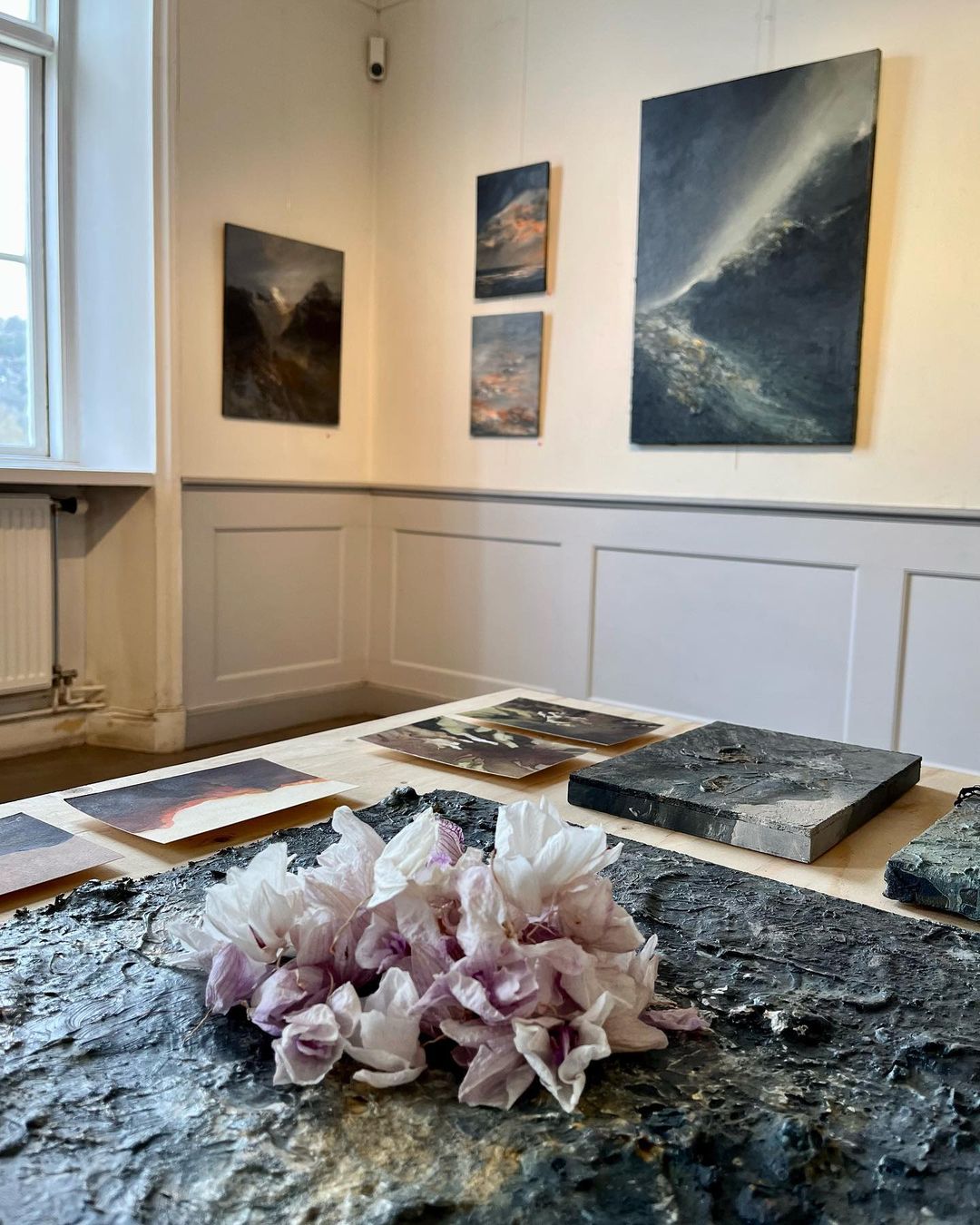
Like you said before, the dialogue is open then.
Yes, the dialogue is open. And I think that is an important and interesting part. Then we stay there and speak about the paintings, but it is just the space where people can watch. These days I always those thoughts, like what is this exhibition about or what is the process here or where do I have to cut the process. I have to put it together and assemble it in some way.

Also like the conversation we are having at the moment. It is not only directly about your artworks, it is also about art itself and how to be creative and what does it mean an what can it be. It is also about the whole topics.
Yes, exactly. And in those spaces it is important for me to sort of showing or talking or presenting to the people at least a certain kind of playfulness. For me it is a sort of play where everything is allowed to fit. And for me that is also connected to life as well. There has to be room for everything.

So not only the open room or space on the canvas, as well the open space at the exhibition and also the open space in the people’s minds. Then it gets all combined together when there is an event like that. Because the people are watching your paintings, they are talking about the topic and it is an open creativity space. The conversations on an exhibitions are of course completely different to a conversation when you meet at the train station or at the job. Because then you are focused on the next station where you have to go or your next work project, but at an exhibition the people’s minds are open for creative thinking. That means the conversations are much more open and creative.
Definitely and of course it is a space for that kind of meeting to take place. I am always curious to meet other people there and to hear what they think about stuff. Not only in that sense of art, but whatever they are thinking about. And that is also why it is interesting to show a bit of the process and making that space something which is not fixed. It needs to be moving. Everything needs to be moving all the time in a way.

Yes, that’s life. It is also very interesting when I am looking here on the painting on the left, because it looks a bit like little paper pieces or leaves from the tree. But then there is another painting which looks like that you put on some stones and other paintings are without applications. So it can be very different how you create the artworks and as well you use some of the painting pieces which are left over while you paint and you use them at artworks itself. So it is interesting to show that.
Yes, absolutely, there are a lot of things in them. It could be something that gives texture, structure or just bare a certain meaning as a material. It could also be like that. For example I could put salt on it, just because it has something. Or sand or gravel. It is also nice to work and to play with the materials and to see what happens with the textures. It is also some way of intuitive painting. That makes it evolving in some way by itself and you need to follow it. Not like by being certain what it is, but by following the process in this and to see where it ends up and what happens with it. So you don’t know where and when it is going to end basically.

So Filip, it was very interesting talking to you and like you said, the process will never finish. It is always an ongoing process and we keep on following your art. It will be interesting to see what new results from you process appear on your channels.
Thank you, it was a really nice conversation and thank you for coming by as a visit, it was a surprise. Everyone is welcome here to knock on the door if you pass by at Stockholmsgatan in Gothenburg. You can also visit my website and the Instagram channel, also you can just send me an email. Thank you, it was fun.

INFOTHEK
![]() Artist: FILIP REM
Artist: FILIP REM
![]() Email: filip@atelierfiliprem.se
Email: filip@atelierfiliprem.se
![]() Website: https://atelierfiliprem.se
Website: https://atelierfiliprem.se
![]() Instagram: https://www.instagram.com/atelierfiliprem
Instagram: https://www.instagram.com/atelierfiliprem
![]() Gallery: ARKIV 8
Gallery: ARKIV 8
![]() Website: http://arkiv8.se
Website: http://arkiv8.se
![]() Facebook: https://www.facebook.com/arkivgatan8
Facebook: https://www.facebook.com/arkivgatan8
![]() Instagram: https://www.instagram.com/arkiv8
Instagram: https://www.instagram.com/arkiv8
![]() Gallery: FLAMÉNSKA GALLERIET
Gallery: FLAMÉNSKA GALLERIET
![]() Website: https://www.flamenska.se
Website: https://www.flamenska.se
![]() Facebook: https://www.facebook.com/flamenska
Facebook: https://www.facebook.com/flamenska
![]() Instagram: https://www.instagram.com/bosk.flamenska
Instagram: https://www.instagram.com/bosk.flamenska
![]() Gallery: PARTILLE KONSTFÖRENING
Gallery: PARTILLE KONSTFÖRENING
![]() Website: https://partillekonst.se
Website: https://partillekonst.se
![]() Facebook: https://www.facebook.com/partillekonst
Facebook: https://www.facebook.com/partillekonst
![]() Photo Credits: FILIP REM & VAGABUNDLER
Photo Credits: FILIP REM & VAGABUNDLER
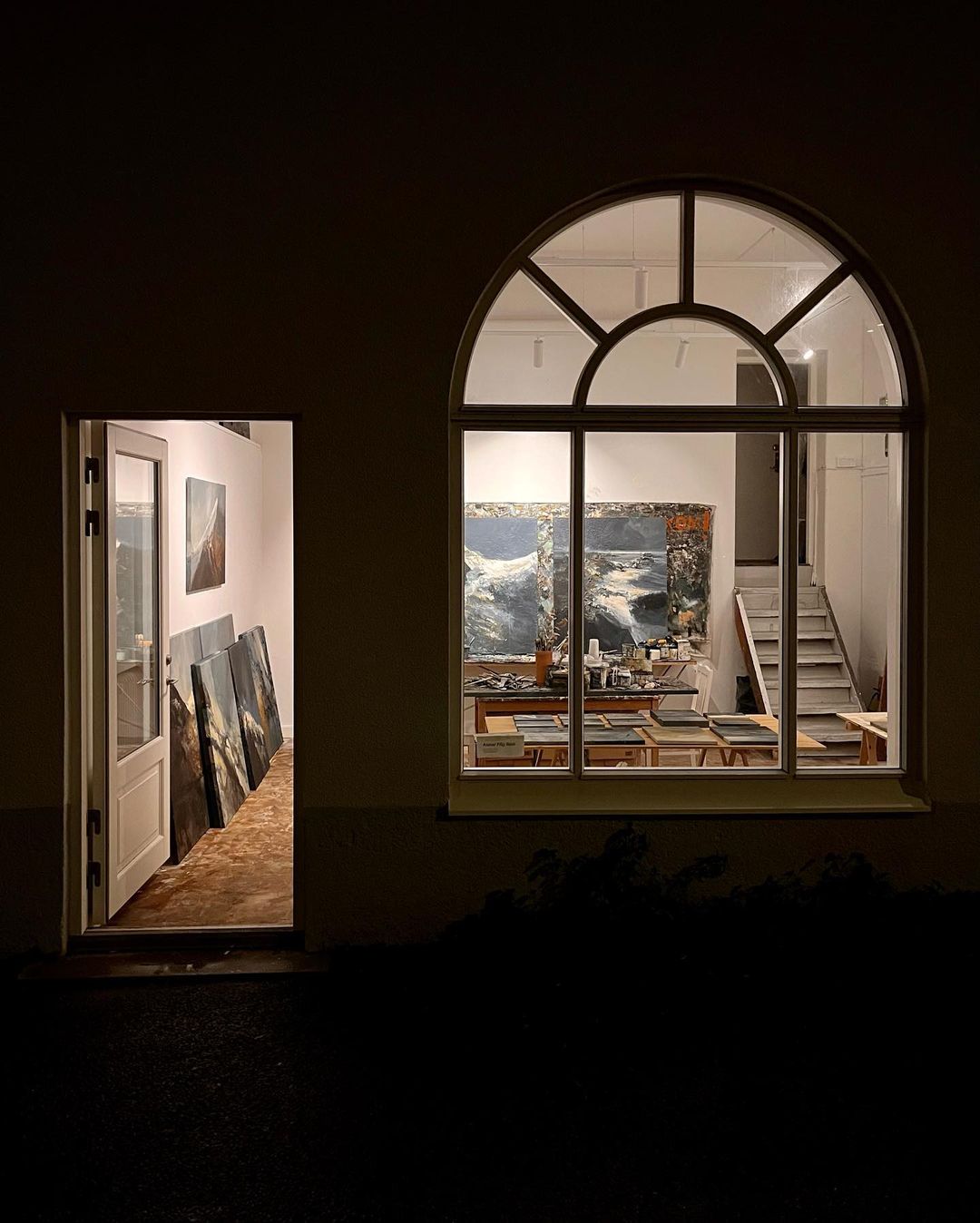
RECOMMENDABLE GRAFFITI SPOTS IN GOTHENBURG
>>> Underground Hall of Fame <<<
>>> Bergsjön Graffiti Hall <<<
>>> Artscape Festivals <<<
>>> Röda Sten Spray Space <<<
>>> Vulkano Art Space <<<
>>> Emigrantvägen Graffiti Wall <<<
>>> Landvetter Graffiti Wall <<<
>>> Gothenburg History Mural <<<
MORE ARTICLES ABOUT SWEDEN
>>> Streetart Map Stockholm <<<
>>> Streetart Map Gothenburg <<<
>>> Streetart Map Borås <<<
>>> Kulturkvarter Snösätra <<<
>>> Streetart Södertälje <<<
>>> Artscape Festivals <<<
>>> #ArtMadeThis <<<
>>> OLLIO – Urban Artist <<<
>>> SCEB – Urban Artist <<<
>>> TONY B – Tattoo & Graffiti <<<
>>> CABEL – Graffiti Artist <<<
>>> CODE 26 – Graffiti Artist <<<
>>> DISK – Graffiti Artist <<<
>>> FILIP REM – Abstract Painter <<<
>>> Movement Biskopsgården <<<
>>> Lost Place Graffiti – Wargöns Bruk <<<
>>> Urban Art – Hammarkullen <<<
>>> Urban Art – Hjällbo <<<
>>> Urban Art – Kungälv <<<
>>> Urban Art – Nödinge <<<
>>> Urban Art – Trollhättan <<<
>>> Urban Art – Vänersborg <<<
>>> Urban Art – Landvetter <<<
>>> Urban Art – Tumba <<<



